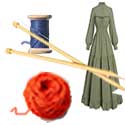Drapers shops in early 20th century England

A draper was either someone who worked in a drapers shop or a shorthand for the shop itself. Drapers were common in the UK until around the middle of the 20th century and dealt with fabrics, sewing items and clothes. They have gone out of fashion with the rise of large supermarkets. This page describes typical old drapers shops and how they stored and priced their wares. It is highlighted with personal recollections.
____
Extracted from the memoirs of the webmaster's mother (1906-2002) and edited by the webmaster with further research and firsthand contributions from others
A typical drapers shop and shopkeeper
When I was a child on the Huxley Estate in Edmonton in the early 1900s, our local draper's shop was typical of other drapers shops I saw.
The shopkeeper was always in the shop but when there were a lot of customers he would call to his wife, who was upstairs, "Are you busy my dear?" She would reply, "I'm always busy", but she would always come down to help.
The shop was fascinatingly tiny, with so much merchandise that there was hardly room to get in. Yet the shopkeeper always seemed to have whatever you wanted and could lay his hands on it immediately.
contributed by Doreen Buckland from personal recollections
I remember from the 1930s that it was amazing how the draper could find anything in his shop although it was so untidy. My mother always said that her sideboard looked like a draper's counter when her children piled things on to it!
Nothing was pre-packed, so if you only wanted a yard of tape or elastic, he would measure it out and cut it off for you.

More typical wooden storage and display units, as used inside drapers' shops, photographed in the Black Country Museum.

Typical wooden storage and display units, as used inside drapers shops, photographed in the Black Country Museum.
How drapers' wares where priced
Farthings [quarters of old pennies] were coins used a lot in the drapers, and if our mothers were owed a farthing in change, they could opt for a small sheet of pins instead. The sheet was always blue and was about 6 inches by 4 inches.
Notes from the webmaster
A drapers shop in a town

A drapers shop window in a town
This photo of an old drapers shop in a town gives some idea of the range of goods that it sold, but there is more. Beside the door there is gold lettering listing the wares. It is interesting how many of these wares go by names which would be unrecognisable today. I have put there modern equivalents in brackets.
millinery (women's hats), blouses, underclothing (underwear), baby linen, hosiery (stockings), ribbons, laces, curtains, calicoes (cotton fabric), etc.
There would be another list on the left of the door, but unfortunately that is out of the photo.
A draper/haberdashery shop in a Victorian terraced house
This image of a front-room draper's shop inside a small Victorian house showing many interesting features.

This photo shows all the features mentioned in the text
The shopkeeper's name is to the left of the door and a shop gas lamp is over the display window to illuminate it.
The outside of a 1925 fancy draper/haberdashery shop in the front room of a Victorian/Edwardian terraced house.
The photo shows how widespread was the style of the Victorian/Edwardian terraces as there is so much similarity between this house in Leicester and the Victorian/Edwardian terraces in North London: the typical tiled garden path (which would have been tiled in red and black), the wrought iron front railings on a low brick wall and the sash windows.
The photo is courtesy of Gary Fleet. The shopkeeper is his great great grandmother, Eliza M. Mcauley (1858-1941), at Green Lane Road, Leicester.
The Roth family of Edmonton drapers
The shopkeeper in our local drapers was Mr Roth. Two of the Roth children were about my age: Leonard Roth and Queenie Roth who were outstandingly brilliant. Queenie went to The Latymer school like my brother, Jim, and she and her brother went on to university.
Note from the webmaster
Information on Edmonton drapers
from the 1911
census and people who remember it
The 1911 census shows that my mother's memory was absolutely right: Morris Roth, 35, draper shop owner, a Russian Poland resident, lived at 79 Silver Street with his wife Jenny Roth, 34, born London City, with their sons Leonard, 6, born Edmonton and their daughter Queenie, 4, born in Edmonton. Pat Cryer
According to the Roth's granddaughter, Kate Varney, 79 Silver Street was the address of the shop. The family lived above it - which fits with my mother's recollections of where Mrs Roth spent most of her time. The Roths moved to 74 Silver Street in Pymmes Villas during the 1920s. Mrs Roth was killed in the bombing. Mr Roth was dug out alive after two days and lived until 1953.
I feel a certain bond with the family because they lived in one of the large houses in Pymmes Villas, Silver Street which was destroyed, along with my husband's Clarke family's house there, in the German bombing of World War Two.
I knew that Mr Roth was in hospital and asked for his bible, and I wish I had asked about Mrs Roth, but I had moved out of the area by then and the bombing of the Clarkes took all my attention.
| sources | webmaster | contact |
Text and images are copyright
If you can add anything to this page or provide a photo, please contact me.



